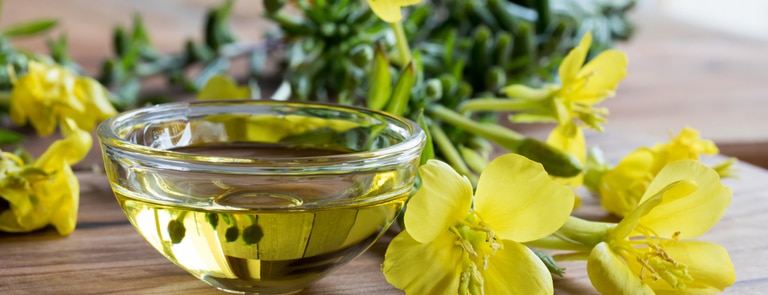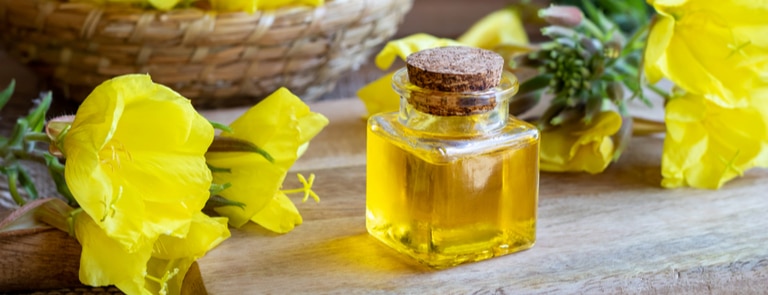Evening primrose oil: Benefits, dosage, side effects, uses & more
06 Sep 2021 • 3 min read
Evening primrose is a plant that’s most commonly found growing throughout Europe and North America.
It’s long been used for all sorts of medicinal purposes, with the Native Americas using the leaves, roots and seed pods to make remedies for bruises, wounds and skin problems.1
Keep reading to find out all about evening primrose oil, including what it does, the benefits of taking it and how much of it you should take.
What is evening primrose oil?
Evening primrose oil is the oil that’s extracted from the seeds of the yellow evening primrose wildflower, Oenothera biennis.
It is a rich source of linoleic acid and gamma-linoleic acid (GLA), both Omega-6 essential fatty acids.2,3
GLA is used to make hormone-like substances called prostaglandins, which can help calm inflammation.4
Many women use evening primrose oil (EPO) to manage symptoms of pre-menstrual syndrome (PMS) and menopause, such as hot flushes.5
EPO is also used to help ease skin conditions, such as eczema and acne.6
Evening primrose oil is most often taken as a capsule but sometimes comes as a liquid.
Summary
Evening primrose oil is a rich source of Omega-6 essential fatty acids, linoleic acid and gamma-linoleic acid (GLA), which are beneficial for easing PMS and menopause-related symptoms, as well as helping with skin conditions.

10 benefits of evening primrose oil
So what does evening primrose do in the body?
Indigenous Americans would use the leaves and bark of the evening primrose plant for stomach and liver complaints.7
EPO is also used as a traditional herbal remedy to relieve the itching associated with dry skin conditions.8
The evidence for taking EPO is still inconclusive, but some studies show it may be helpful for:
-
Menopause symptoms
There’s a lot of anecdotal evidence from menopausal women that using evening primrose oil can ease hot flushes.
One 2013 study found taking EPO for six weeks could relieve the frequency, intensity and length of hot flushes.
The women in the study also reported a significant improvement in their sense of wellbeing.9
-
Pre-menstrual syndrome (PMS)
Many women take EPO for PMS symptoms, such as water retention, breast tenderness and low mood; the Royal College of Obstetricians and Gynaecologists reports that it can ease breast tenderness.10
A 1983 study concluded that taking EPO was ‘highly effective’ for treating symptoms of PMS,11 but more research is needed.
-
Dry skin conditions
The European Medicines Agency says EPO can be used to relieve itching in short-term and long-term dry skin conditions,12 and is often taken by people with eczema to help prevent dry, itchy skin.13
But a 2013 Cochrane Review concluded evening primrose oil is no more effective than a placebo in treating eczema.14
-
Acne
It’s thought the GLA in evening primrose oil may improve acne by reducing inflammation and minimising scarring, with a Korean study carried out in 2014 concluding that GLA reduced inflammation in acne sufferers.15
More evidence is needed before EPO can be recommended as an acne treatment.
-
Arthritis
EPO is often used by those with rheumatoid arthritis to ease pain and stiffness.
One study found taking it helped ease morning stiffness in patients with the condition.16
Versus Arthritis says, while the evidence isn’t conclusive, it may ‘help in the regulation of pain and inflammation'.17

-
Osteoporosis
Increased levels of unsaturated fat are linked with a reduced risk of osteoporosis (bone mineral loss), especially in postmenopausal women.
Due to the fact evening primrose oil is made up almost entirely of unsaturated fat, it’s believed to help prevent bone in women with osteoporosis, as well as older people.18,19
-
Bile flow
Initial studies have concluded that taking 2g of evening primrose oil twice a day for 12 weeks improves itchy skin in some people with disorders affecting bile flow in the liver.
Signs of improvement start to show within 1 to 2 weeks of treatment starting.20
-
Chronic Fatigue Syndrome (CFS)
One initial study found that taking a specific combination of evening primrose and fish oil may potentially reduce CFS-like symptoms that occur after a viral infection.
However, in another study in people with a confirmed diagnosis of CFS, the same product was no better than a placebo (sugar pill).21
-
Dry eyes
Early research has indicated that taking a specific evening primrose product – 3g a day for 6 months - improves dry eye symptoms in female contact lens-wearers.22
-
Cholesterol levels
Some studies have revealed evening primrose oil can decrease total cholesterol and blood fats (triglycerides) while increasing good (HDL) cholesterol.
Meanwhile, other studies have concluded the opposite.
More research is therefore required.23
Summary
Evening primrose oil is believed to deliver several health benefits, some of which have been proven by research and some that are yet to be proven.
Benefits include improving PMS and menopause symptoms and helping with dry skin conditions and dry eyes and reducing inflammation caused by acne.

Dosage
Is it OK to take evening primrose oil every day?
While it’s believed to be safe for adults to take 500mg of evening primrose oil a day, and even, up to 1,300mg a day, it shouldn’t be given to children unless under the advice of a health professional.24
There is no official ‘upper limit’ for EPO, but the European Medicines Agency warns that children under 12 should not take it.25
You should also avoid taking EPO if you:26,27
- Are on blood-thinning drugs like Warfarin – this is due to the fact EPO has blood-thinning effects.
- Are due to have surgery in two weeks – EPO may cause excessive bleeding if you continue to take it right up until your surgery date.
- Have epilepsy, schizophrenia or any other seizure disorder - there’s a chance evening primrose oil may increase the risk of seizure.
- Are pregnant - EPO can cause complications and may increase the risk of miscarriage or induced labour.
Always check with your healthcare professional before taking evening primrose oil and read the label, as dose instructions may vary between products.
When to take evening primrose supplements
Should you be taking evening primrose oil in the morning or night?
Always follow the manufacturer’s guidance when it comes to taking EPO; not taking it as directed could potentially impact results.
Generally speaking, EPO is taken every day – around one to three evening primrose oil capsules should be taken, preferably with a meal to aid absorption.
In terms of whether you take it first thing or at night, follow the recommended guidance.
Usually, it’s a case of taking it at a time that you’re most likely to remember and works best for you.
Summary
It’s possible for adults to take EPO every day, but it’s important they stick to the recommended dosage.
It shouldn’t be given to children unless directed by a health professional.
You shouldn’t take it if you are on blood-thinning drugs, have epilepsy or similar, or are pregnant.
Evening primrose side-effects
The side-effects of taking EPO are normally mild and include:28
- Nausea
- Diarrhoea
- Indigestion
- Headaches
- Allergic reactions (this is rare) - if you notice a rash, itching or breathing difficulties after taking it, seek medical attention immediately
More serious side-effects of taking EPO include:29
- Increased risk of bleeding – if taken alongside anticoagulant and antiplatelet medication
- Increased risk of seizures – among people taking medication (phenothiazine) for schizophrenia and other psychotic disorders
- A drop in blood pressure – in people who are on medication to lower their blood pressure; EPO may reduce it even further
- Cause seizures – if you take it at the same time as being given an anaesthetic
Summary
There are several side effects associated with taking EPO; some mild, such as sickness and headaches, and some severe, such as the increased risk of bleeding, reduced blood pressure and seizures.
Last updated: 6 September 2021
The advice in this article is for information only and should not replace medical care. Please check with your GP or healthcare professional before trying any supplements, treatments or remedies. Food supplements must not be used as a substitute for a varied and balanced diet and a healthy lifestyle.